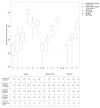SARS-CoV-2 Aerosol Transmission Indoors: A Closer Look at Viral Load, Infectivity, the Effectiveness of Preventive Measures and a Simple Approach for Practical Recommendations
- PMID: 35010484
- PMCID: PMC8750733
- DOI: 10.3390/ijerph19010220
SARS-CoV-2 Aerosol Transmission Indoors: A Closer Look at Viral Load, Infectivity, the Effectiveness of Preventive Measures and a Simple Approach for Practical Recommendations
Abstract
There is uncertainty about the viral loads of infectious individuals required to transmit COVID-19 via aerosol. In addition, there is a lack of both quantification of the influencing parameters on airborne transmission and simple-to-use models for assessing the risk of infection in practice, which furthermore quantify the influence of non-medical preventive measures. In this study, a dose-response model was adopted to analyze 25 documented outbreaks at infection rates of 4-100%. We show that infection was only possible if the viral load was higher than 108 viral copies/mL. Based on mathematical simplifications of our approach to predict the probable situational attack rate (PARs) of a group of persons in a room, and valid assumptions, we provide simplified equations to calculate, among others, the maximum possible number of persons and the person-related virus-free air supply flow necessary to keep the number of newly infected persons to less than one. A comparison of different preventive measures revealed that testing contributes the most to the joint protective effect, besides wearing masks and increasing ventilation. In addition, we conclude that absolute volume flow rate or person-related volume flow rate are more intuitive parameters for evaluating ventilation for infection prevention than air exchange rate.
Keywords: SARS-CoV-2; airborne transmission; infection prevention; risk assessment model; simplified approaches.
Conflict of interest statement
The authors declare no competing interest.
Figures










References
MeSH terms
Substances
LinkOut - more resources
Full Text Sources
Medical
Miscellaneous

